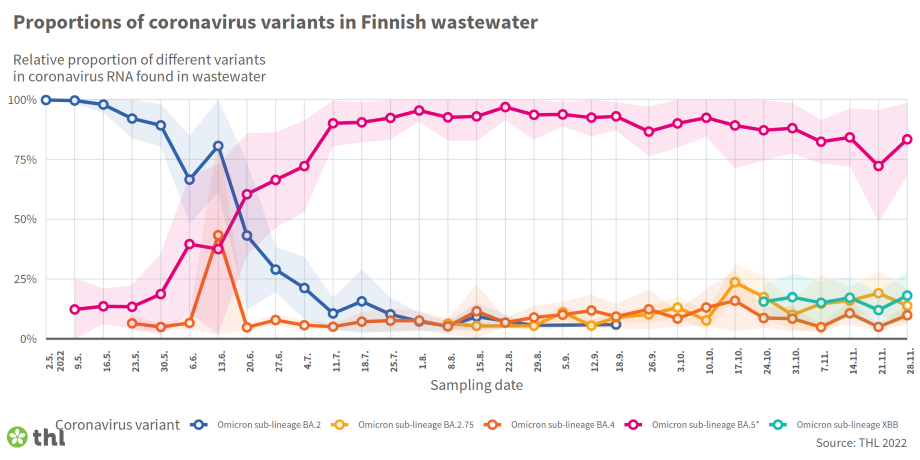Monitoring wastewater for coronavirus: XBB sublineage of Omicron variant found in wastewater, follow-up results coming in January
The new XBB sublineage of the Omicron variant has been found in wastewater monitoring for the coronavirus.
XBB was first detected in wastewater in Espoo and Helsinki in late October and the sublineage was included in reports on wastewater analysis in December. The most recent wastewater variant results are from samples collected on 28 November.
XBB is a recombinant sublineage of the BA.2.10.1 and BA.2.75 sublineages.
It has also been detected since late October in sequenced samples taken from humans. However, its proportion in samples does not seem to increase very fast.
Several different sublineages of the Omicron variant are now spreading in Finland. The formation of new sublineages and variants is part of the natural evolutionary process of viruses. At present there are no indications of variants or sublineages that would cause more serious illness than usual.
“The XBB and BA.2.75 sublineages descending from the BA.2 sublineage of the Omicron variant, as well as BA.4 and BA.5 sublineages can now be found in Finnish wastewater. There have been no significant changes in the relative proportions of the sublineages of the Omicron variant since July; since then, the BA.5 and the sublineages that descend from it have been the most common subvlineages found in wastewater”, says THL Senior Researcher Anssi Lipponen.
Many of the BA.5 sublineages are very similar to the main lineage and distinguishing them from each other in wastewaer samples is not possible at present.

Relative proportions of different SARS-CoV-2 virus variants in Finnish wastewater found in sequenced wastewater samples from monitored wastewater treatment plants between 2 May and 28 November 2022. The lighter-shaded area represents the standard deviation from the results of different treatment plants. The Omicron BA.5 sublineage is now clearly the most common in wastewater samples. Also included in the monitoring are the XBB, BA.2, BA.4 and BA.2.75 lines whose proportional shares have remained low.
A fairly even rising trend has been seen throughout the autumn period in the numbers of coronavirus genotypes, or RNA, in wastewater in Finland. The most recent samples of wastewater were collected on 18-19 December 2022 and the weekly report is being published exceptionally already on Thursday 22 December.
The increase in the amount of coronavirus in wastewater indicates a typical autumn and early winter infection period that can also be seen in an increase in respiratory tract infections. There has been no corresponding rise in cases of COVID-19 confirmed by laboratory tests, because health care services are conducting only limited numbers of COVID-19 tests, for example, on members of at-risk groups for severe coronavirus disease who exhibit symptoms of the disease.
Changes to implementation of wastewater monitoring in January
The preliminary treatment method for samples used in wastewater monitoring by THL has been under development in the last part of the year. The new method is not as sensitive to problems of availability of equipment as the method that is now in use.
The first results of wastewater monitoring using the new method will be reported on 13 January 2023.
Wastewater monitoring for coronavirus will be on a two-week break between 23 December 2022 to 7 January 2023.
Espoo is currently taking its new wastewater treatment plant in Blominmäki into use. The results of wastewater testing the Blominmäki treatment plant will be included in the weekly report after the Christmas break.
The treatment plant will process the wastewater of about 400,000 residents in Espoo, Kauniainen, Kirkkonummi, Siuntio, and West Vantaa, which was previously processed at the Suomenoja wastewater treatment plant. The deployment of the new treatment plant means that results from the Suomenoja wastewater treatment plant will not be included in the weekly reports at the end of the year.
Further information
- Further information on coronavirus variants in wastewater
- Weekly report on wastewater monitoring for coronavirus (in Finnish)
- Coronavirus variants
- SARS-CoV-2 coronavirus genome monitoring (in Finnish)
- Coronavirus wastewater monitoring
Anssi Lipponen
Senior Researcher
THL
+358 29 524 7962
[email protected]



